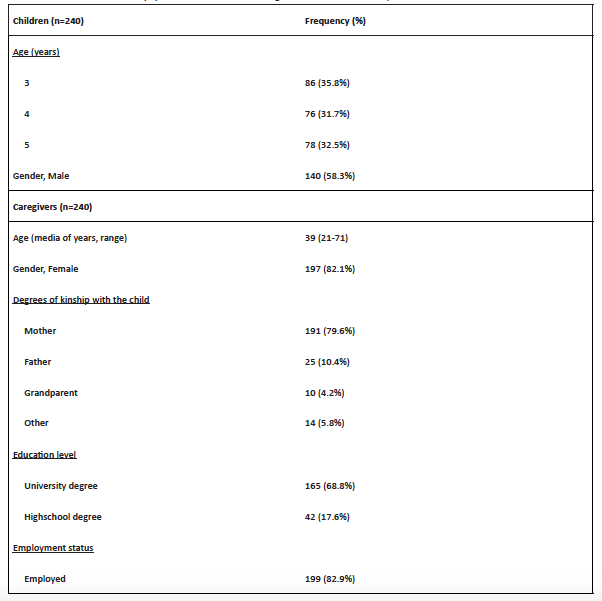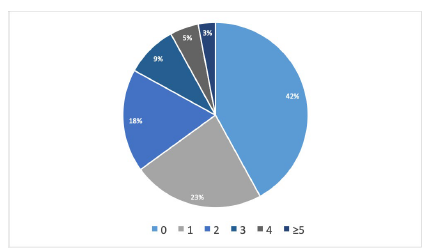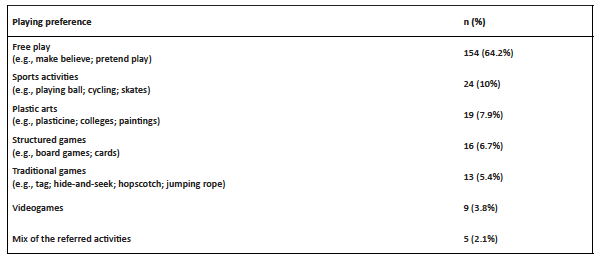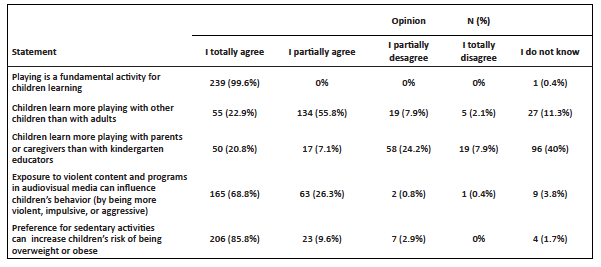Introduction
Playing is a child’s right and an essential activity for his/her development, thus representing the key verb of childhood.1,2 Today’s society, marked by technological development and growing demand for children’s performance in various areas, determines several barriers to child participation in playing. Increasingly early exposure to audiovisual media, a great amount of time spent at school or in extracurricular activities, and lower parental availability are acknowledged threats to play.2
Understanding how children play and how caregivers understand play is key for defining intervention areas and strategies. However, studies investigating the playing habits of children in Portugal are scarce.
The primary goal of this study was to characterize the playing habits of Portuguese children aged three to five years. Secondary goals were to characterize their sleeping habits, exposure to screens, and behavior, as well as caregivers´ perception of these aspects.
Material and methods
This was an observational, cross-sectional study based on the application of an online questionnaire to parents and main caregivers of children aged between three and five years. A convenience sample was retrieved through inclusion of all caregivers who accessed the online survey and correctly completed it. Those who were not the main caregivers of children in the referred age range were excluded. Study participants provided informed consent to participate, and the study was approved by the Ethics Committee of the participating hospital. Data were collected during July 2018. The questionnaire was subdivided into the following sections: sociodemographic characterization of caregivers and characterization of their interaction with children; sociodemographic characterization of children and characterization of their playing habits, screen exposure, sleep, and behavior; and questions of opinion, with closed answer (from “totally agree” to “totally disagree”).
Categorical variables were expressed as frequencies and percentages. Comparisons between categorical variables were performed using the ꭓ2 test. Binary logistic regression was used to calculate odds ratios [OR] in multivariate analysis. The inclusion of variables into multivariable model was tested using the forward stepwise selection method. Statistical significance was accepted for P values <0.05, and statistical analysis was performed using IBM SPSS Statistics, version 22 (IBM, Armonk, New York).
Results
A total of 240 valid online questionnaires was retrieved. Table 1 depicts the study population, which comprised 58.3% (n=140) of male children and had the following age distribution: 36% (n=86) of three-year-olds, 31.6% (n=76) of four-year-olds, and 32.4%(n=78) of five-year-olds. Regarding caregivers, the population included had a median of 36 years (range 21-71) and was mostly composed of mothers (79.6%; n=191), followed by fathers (10.4%; n=25), grandparents (4%; n=10), and others (6%; n=14). Concerning education level, 68.8% (n=165) of caregivers had a university degree and 17.7% (n=42) had completed high school. Additionally, 82.9% (n=199) were employed.
Although 68.3% (n=164) of caregivers said they played with their children daily, 95% (n=228) would like to do it more often. Lack of time was the main limiting factor (77.9%; n=187), although 3.3% (n=8) claimed not knowing “how to play with the child”. A minority (5%, n=12) admitted playing with children only on weekends or holidays. As for the daily amount of time spent playing with children, 24.2% (n=58) did it for up to 30 minutes, 36.3% (n=87) between 30-60 minutes, and 39.6% (n=95) for more than one hour.
Most children (93.8%, n=225) attended kindergarten, 80.8% (n=194) for six or more hours a day, and 57.1% (n=137) attended at least one extracurricular activity (Figure 1). The majority (64.2%; n=154) played outdoors in most days, with 32.9% (n=79) doing it only on weekends and 2.5% (n=6) rarely. A significant percentage of children (80.8%, n=194) daily interacted with other children, including brothers, cousins, and neighbors.
Regarding playing options, free play (e.g., make-believe and pretend play) was the preferred by children (64.2%, n=154), followed by sports (10%; n=24), plastic arts (7.9%; n=19), and video games (3.8%; n=9; Table 2). Approximately a third (34.2%, n=82) of caregivers acknowledged often influencing their children on what to do or how to play.
Most children (77.5%, n=186) had contacted with audiovisual media (TV, tablet, mobile phone, computer, or console) before the age of 18 months, with 44.6% (n=107) using these devices daily for one to three hours and for more than three hours in 6.5% (n=16) of cases. Most children (77.4%, n=186) did not have these devices in the room. The first contact with books was before the age of 12 months for 75.2% (n=180) of children.
When asked about their children’s sleeping habits, 89.6% (n=214) of caregivers considered that they slept well. Most children had their own room (88.3%; n=212) and their own bed (93.9%; n=225). About 52.8% (n=127) of children always or almost always required the presence of an adult to fall asleep, and 37.4% (n=90) always or almost always called for an adult to fall asleep if waking up at night. Most children (86.3%, n=207) slept eight to 13 hours, 7.5% (n=18) eight to 10 hours, 5.4% (n=13) less than eight hours, and 0.83% (n=2) more than 13 hours per day.
Concerning children’s behavior, 85.8% (n=206) of caregivers considered that they were able to remain seated and concentrated on quiet activities, 27.5% (n=66) stated that they had frequent tantrums, and 21.3% (n=51) acknowledged that they were impulsive or aggressive. A small percentage (7.5%, n=18) frequently suffered from headaches or abdominal pain, and 1.3% (n=3) were regularly tired, unmotivated, or uninterested. Children who did not sleep well (i.e., at least 10-13 hours a day or have other sleeping problems in the caregiver’s perception) were more often impulsive or aggressive and less focused on quiet activities and had more regular tantrums (p<0.05) (Table 3). In multivariate analysis, the focus on quiet activities (less focused vs. focused, OR 4.638, 95% CI 1.902-11.314) and frequent tantrums (frequent vs. infrequent tantrums, OR 2.317, 95% CI 1.022-5.250) were independent predictors of sleeping problems, but not impulsive/aggressive behavior.
Answers to questions of opinion revealed that 99.6% (n=239) of caregivers completely agreed that “playing is a fundamental activity for learning”, and the majority (79.2%, n=190) agreed that “children learn more while playing with other children than with adults” (Table 4). A little less than half of caregivers (47.1%; n=113) partially or totally agreed that “children learn more while playing with their parents or primary caregivers than with kindergarten educators”. Finally, it was mostly unanimous that “exposure to violence in audiovisual media can influence children’s behavior” and that “the preference for sedentary activities can increase the risk of obesity/overweight”.
Table 3 Relation between children´s behavior and sleeping habits

“Sleeps well” - considering the caregiver’s subjective opinion and that the child sleeps 10-13 hours per day.
Discussion
The importance of playtime in children’s development is largely acknowledged in the literature and was also recognized by most caregivers in this study.1,2 It represents a key action for multiple functional and structural brain processes, namely behavior modulation, socio-emotional skills, language, mathematical reasoning, creativity, and imagination, all of which are fundamental aspects of learning.3-7 It is also an important way of regulating stress, impulsivity, and aggressiveness, improving self-regulation, and stimulating parental independence.8,9
Although most caregivers in the present study stated that daily played with their children, most would like to do it for longer, with lack of time being the main obstacle for not doing so. This agrees with results from another Portuguese study, according to which 63.3% of parents spent one to three hours a day playing with their children and 26.2% up to one hour a day.10 Spending time playing with children intensifies emotional bonds, which is crucial to foster the exploration of the unknown by the child. Children learn in a continuous way, not only in formal settings such as school but also through caregivers and daily experiences, and this informal process is crucial and should be reinforced.9 Everyday activities, such as housework, going to the supermarket, or car trips, are examples of opportunities for interaction, playing, and learning.8,9
Most children in this study spent at least six hours daily in kindergarten and had at least one extracurricular activity. Caregivers’ demanding working schedules are preponderant factors in such use of children’s time, but other factors may also play a part. Nowadays, social focus on academic success leads to an excessive encouragement of structured activities at the expense of free play time, as it is commonly believed that they are crucial for children’s development.9,10 However, too many scheduled hours, associated with the lack of free time for playing and spending quality time with the family, is highly limiting of creativity and may relate to anxiety and depression later.9 School preparation should encompass a holistic perspective (including socio-emotional, behavioral, and cognitive aspects),11 and the importance of playing in the acquisition of functional and executive competencies and in adult life has been largely recognized.12 The false dichotomy between playing and formal learning has been replaced by the value of “playful learning”, through the active and happy discovery of contents, achieved through innate curiosity and motivation and associated with content memorization.13-17
Most children in this study played outside in most days, in contradiction with the tendency of disregarding outdoor playtime for being unsafe and for lack of playgrounds and green spaces in urban settings, leading to a “nature deficit”.18,19 Excessive concerns about getting dirty, self-injuring, getting wet, etc., may be an exaggerated tendency of modernity and an obstacle for resilience construction.20
The fact that most caregivers in this study recognized the importance of promoting playtime between their children and other children is a positive aspect, as playtime with peers is the cornerstone of the development of social capacities, namely cooperation, negotiation, teamwork, conflict resolution, leadership capacity, and self-defense capacity.21,22
Free play was identified as the preferred playing option in this study. A systematic review from 2015 consistently showed that free play contributed to children’s physical and mental health.23 Importantly, a study in animal models explored the consequences of free play deprivation and showed underdevelopment of pre-frontal cortex areas, limiting the individuals’ ability for problem resolution, sociability, and maturity.10 In role-play playing, children make up and establish rules, which is important for creativity development, promotion of self-regulation, and capacity of abstract reasoning in hypothetical scenarios.5,6 All forms of play have benefits: sports are important for the development of motor skills and learning to cooperate, plastic arts stimulate creativity, and structured gaming teaches how to follow rules and accept defeat.9 Only a small percentage of children (3,8%) indicated videogames as the main play activity. Multimedia exposure predisposes to passivity and sedentarism, discourages curiosity and language, and takes away time from active play and interaction with others.9
Most parents said they did not interfere with the way their children played. This is relevant, as curiosity, independence, and language development are constrained when adults are intrusive and directive in children´s playing.9
Most children in this study were exposed to audiovisual media before the age of 18 months, contrary to recommendations of the American Academy of Pediatrics (AAP) for limiting exposure to videoconferences with the close family in this age group.24 Screen time also seemed to be excessive in about half of cases. Both AAP and the World Health Organization (WHO) recommend that children between two and five years old should only watch programs of high educational value, for up to one hour daily, and under supervision.24,25 The present study did not account for the type of screen or program used. A study from 2017 by the Regulating Entity for Social Communication reported that television was the predominant audiovisual media in Portuguese children aged between three and eight years, and 94% of children watched television every day, on average for one hour and 41 minutes,26 which is consistent with this study’s results. While well-designed television programs can improve cognitive, literacy, and social outcomes in children between three and five years old, skills and executive functions for school success are best acquired through social play and parent-child interaction.27 Exposure of children to violent content and programs in the media concerned most caregivers inquired, highlighting that those should be carefully selected.
WHO recommends that children spend at least 180 minutes daily in physical activities of varying intensity and at least 60 minutes daily in moderate to vigorous activities, which can and should encompass different ways of playing and gaming.25 Most caregivers in this study were aware that sedentary activity increases obesity risk. Childhood is a critical period for the development of motor competencies and acquisition of healthy lifestyles. Active playing is associated with prevention of cardiovascular diseases, stress, and depression, and with improvement of agility, coordination, balance, and flexibility.9 WHO recommends that part of sedentary activities include reading,25 and three-quarters of children in this study had contacted with books before the age of 12 months, which represents a positive study finding.
Regarding sleeping habits, most parents considered that their children slept well, but around 50% of children required parental involvement to fall asleep, and around one-third had night awakenings. Studies indicate that direct parental intervention in children’s falling asleep should gradually decrease and that they should fall asleep on their own and independently of the caregiver.28 Night awakenings in small children are frequent and can be related to separation anxiety and poor sleep quality.29 Most children in this study slept the recommended daily time (10-13 hours), but previous data had shown that most children in Portugal do not get adequate sleep.28 A child aged three to five years old should sleep between 10 to 13 hours a day, including a one-to-three-hour nap, which is not always foreseen in preschool institutions.28 In fact, sleeping problems in children are mostly undervalued.29 Sleep deprivation in children is associated with poor mental and physical health, including attentional and behavioral problems, increased impulsivity, and mood and memory changes, compromising the learning ability. Results of this study, showing a high prevalence of children with adequate sleep time (Table 3), are consistent with the evidence in the literature.28,29
About half of children in this study presented behavior changes (tantrums, impulsiveness/aggressiveness), with a minority showing physical symptoms. These represent normal features in the development process and were predicted. Tantrums peak between two and three years of age, a period when the child is acquiring autonomy and trying to dominate the environment. At this age, 20% of children have tantrums at least once a day, and 50-80% at least once a week. Explosive temper persists during childhood in only 5% of children. However, excessive tantrums, both in frequency and intensity, may constitute warning signs for neurodevelopment and behavior disorders.30
This study has several limitations that should be acknowledged, starting with its convenience sampling and online data retrieval, which precluded the inclusion of individuals without an internet connection. On the other hand, the fact that data retrieved was based on the subjective report of caregivers, added to their high education level, may have influenced the results obtained. The use of non-validated questionnaires or scales, namely for the assessment of mental health, behavior, and sleep, are also relevant study limitations. Importantly, since this study was conducted before the pandemic outburst, a comparative study in the post-pandemic setting will be predictably interesting.
Conclusion
The great changes that society underwent over the past years led to modifications in the way children play and in their leisure experiences. Most parents and caregivers recognize the importance of playing, and most children choose “free play” as the preferred activity. In addition, the preference for playing outdoors and with other children were positive findings of this study. On the other hand, inadequate screen exposure, time overload in structured activities, and lack of caregiver availability seem to be the main challenges for children and caregivers nowadays and should be discussed during pediatric consultations as part of a global health assessment.
Playing should be taken very seriously in children’s development process, and providing conditions for playing should be a priority for professionals, caregivers, and decision-makers.
More studies should be conducted on this subject, namely investigating the association between playing habits and health indicators, encouraging reflection and social-political decision to defend this fundamental child’s right.



















